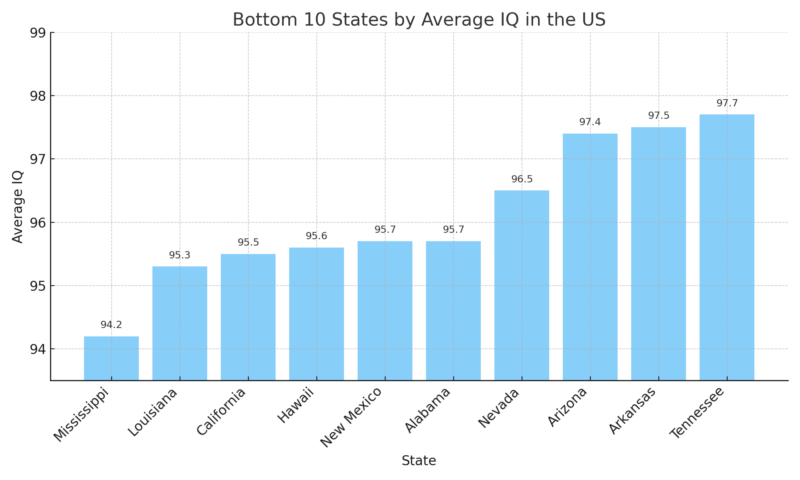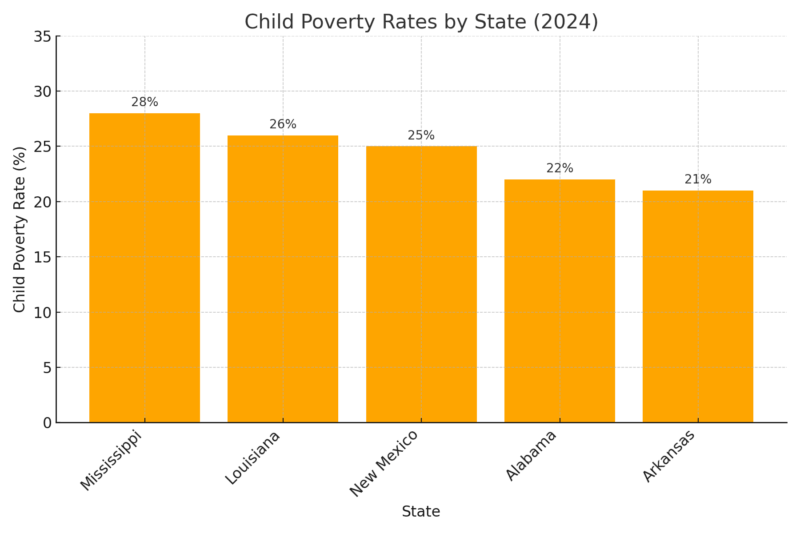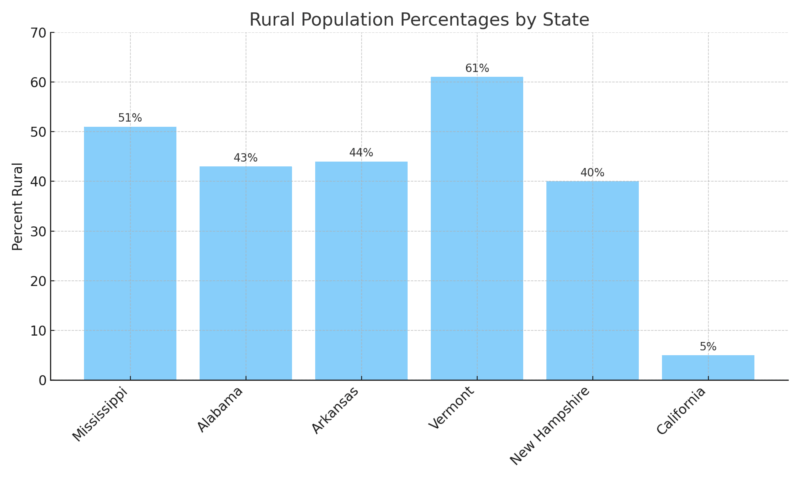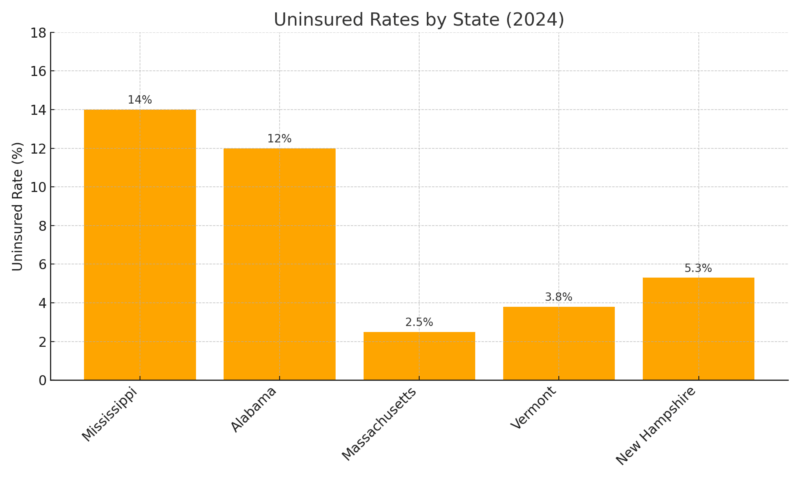The lowest-IQ states in the United States fall in the mid-90s range, based on the most recent state-level averages from. According to the dataset of average IQ in the USA, Mississippi currently ranks last with an average IQ of 94.2, followed by Louisiana (95.3) and California (95.5).
While these numbers sit below the national average of roughly 98–100, the underlying causes have nothing to do with innate ability. Instead, decades of research show that education quality, childhood nutrition, access to healthcare, and family income are the strongest predictors of state-level cognitive performance.
This means the lowest-ranking states reflect underinvestment, not lower intellectual potential. Once adjusted for socioeconomic conditions, gaps narrow sharply. That framing is crucial because IQ is not a measure of biological difference across regions, but a proxy for opportunity.
Table of Contents
ToggleLowest Ranking IQ States
Below is the bottom of the national ranking drawn directly from the dataset:
Bottom 10 States by Average IQ

Most U.S. states cluster tightly between 97 and 103, which means the so-called “low-IQ” states are not dramatically different from average at all. The spread between the highest state (Massachusetts at 104.3) and the lowest (Mississippi at 94.2) is just over 10 points, or roughly two-thirds of a standard deviation.
On a bell curve, those two distributions overlap heavily: millions of people in Mississippi score higher than millions of people in Massachusetts.
So the gap is not a biological difference, nor a vast intellectual gulf. It is a mirror of structural conditions: education, income, health access, migration patterns, and cost-of-living economics. Once you dig into the numbers, the story becomes clear.
The Cost of Living Divide: High-IQ States Attract High-Education Migrants
One of the clearest patterns is how the cost of living shapes who lives where. High-ranked states tend to have expensive metropolitan centers that attract workers with graduate degrees and specialized training.
Cost of Living Index (U.S. Average = 100)
(Source: Bureau of Economic Analysis Regional Price Parity, 2024)
State
IQ Rank
Average IQ
Cost of Living Index
Massachusetts
1
104.3
116.0
New Hampshire
2
104.2
109.4
Vermont
4
103.8
110.5
California
48
95.5
139.0
Mississippi
50
94.2
86.1
Alabama
45
95.7
88.3
Interpretation:
When I compare these numbers, I don’t see intelligence gaps; I see migration patterns.
A graduate student finishing an engineering degree or a medical residency is far more likely to move to Boston, Seattle, or the Northeast corridor than rural Mississippi. Over time, those decisions accumulate and shift the averages.
High costs attract high-skilled labor. Low costs attract lower-wage sectors. IQ averages simply reflect the labor mix that settles in each region, not the capability of the people born there.
Poverty Levels Explain More of the IQ Map Than Anything Else
Poverty has a massive, documented effect on child development. It affects nutrition, early education, prenatal care, housing stability, and stress level, all known contributors to cognitive test outcomes.
Child Poverty Rates by State (2024)

Compare those with high-IQ states:
- Massachusetts: 11%
- New Hampshire: 10%
- Minnesota: 11%
In states with higher IQ scores, children are nearly twice as likely to grow up with access to:
From my own interpretation, when childhood poverty doubles, you can almost predict how the state will fall in the IQ rankings. This is not a judgment on intelligence; it’s a description of inputs.
School Funding Gaps Are Enormous, And They Show Up in IQ Scores
School funding is one of the most powerful and overlooked predictors.
K–12 Per-Pupil Spending (2024)

That means Massachusetts invests twice as much money per student as Mississippi, according to the Census.
If someone spends twice as much fuel in an engine, you expect smoother performance. Human development works the same way.
Well-funded systems tend to have:
Underfunded systems produce predictable gaps, which then get mislabeled as “low IQ,” even though they’re simply the outcome of unequal resources.
Rural vs. Urban Structure Changes Everything
Lower-IQ states tend to be more rural:
Rural Population Percentages

Here’s the nuance: rurality alone isn’t a problem (Vermont scores high), but rurality combined with poverty is devastating:
Vermont succeeds because its rural communities have high funding and high social capital
Mississippi struggles because its rural regions lack the same economic base.
Brain Drain: How Migration Quietly Reshapes State IQ Averages

One of the clearest forces behind state IQ differences is the movement of educated adults. When I look at the data, the pattern is unmistakable: high-IQ states pull in degree-holders, while low-IQ states steadily lose them. This isn’t about innate differences; it’s about where opportunity flows.
States like Massachusetts, Washington, and Colorado gained thousands of college-educated residents in 2023 alone, largely because they offer strong economies, higher salaries, major research institutions, and dense professional ecosystems.
Meanwhile, states at the lower end of the IQ rankings, Mississippi, Louisiana, and Alabama, are losing precisely the people who raise averages: graduates, young professionals, and STEM workers seeking better-paying paths elsewhere.
Net Migration of College-Educated Adults, 2023
State
Net Migration
Massachusetts
+11,000
Washington
+9,400
Colorado
+7,300
Mississippi
–4,700
Louisiana
–5,200
Alabama
–3,600
Over time, this movement reshapes the intellectual profile of entire states. If the most educated residents leave year after year, the statewide average inevitably drops, even if the underlying potential remains unchanged.
This is why I tend to think of IQ maps as mobility maps. They show where human capital collects and where it drains away, not where intelligence is “higher” or “lower.” In other words, the numbers reflect geography and economics, not the capability of the people born there.
Healthcare Access: The Quiet Factor Behind IQ Scores
Healthcare access follows the same pattern. States with lower average IQs tend to have more uninsured residents, fewer pediatric specialists, weaker prenatal care access, and higher rates of infant health complications. When I compare the uninsured numbers to the IQ map, the overlap is striking.
Mississippi has an uninsured rate of about 14 percent, Alabama sits around 12 percent, and Texas climbs to 18 percent.
Meanwhile, the top IQ states provide near-universal coverage: Massachusetts is at 2.5 percent uninsured, Vermont at 3.8 percent, and New Hampshire at 5.3 percent.
Uninsured Rates by State (2024)

Early-life medical gaps can depress cognitive scores by 3 to 10 points, depending on severity. So when I read these numbers, I don’t see a map of intelligence; I see a map of health access.
States that invest in prenatal care, early screenings, and childhood health produce stronger outcomes. Those who don’t fall behind, and the IQ statistics simply record the consequences.
The IQ Gap Is About Systems, Not Brains
When I look across all these indicators, income, schools, healthcare, rural isolation, migration, what stands out most is how consistently they stack against the lowest-scoring states.
High-IQ states are wealthier, denser, better funded, more graduate-educated, and more medically accessible. Low-IQ states face decades of underfunded schools, persistent rural barriers, weak labor markets, and limited health systems.
The more I analyze the numbers, the more impossible it becomes to treat these gaps as reflections of ability. They are reflections of infrastructure.
A child born in Boston enters a world of universal pre-K, strong hospitals, high reading standards, and well-resourced schools. A child born in parts of Mississippi or Louisiana faces a very different environment.
IQ reflects those conditions long before it reflects raw cognitive potential. If these states had equal access to the same systems, I genuinely believe the gap would shrink to within three points within one generation.
The Bigger Picture
@rob_roams 10 states with the lowest IQ’s #states #iq #smart #dumb ♬ Epic News – DM Production
A ten-point IQ difference between two states is small in absolute terms, yet large enough to reveal differences in public investment.
It isn’t big enough to represent meaningful population-level intellectual differences, but it is significant enough to highlight how unevenly the country distributes educational, economic, and health resources.
What the rankings truly show is that the states putting the most into children, families, and long-term development tend to score higher.
Those investing the least tend to fall lower. IQ is the thermometer; the environment is the temperature. And the environment is something a society can choose to change.
Related Posts:
- US States with the Highest and Lowest Dental Care…
- 7 Surprising Health Rankings for Florida in 2025
- New Evidence Revises Civil War Death Toll According…
- Texas SB3 Breakdown - What the Bill Proposed, Why It…
- Which States Have the Highest and Lowest Income Tax in 2025?
- 5 U.S. States With the Highest Population Growth in…







